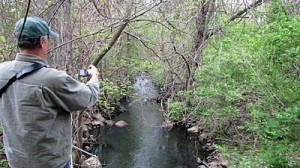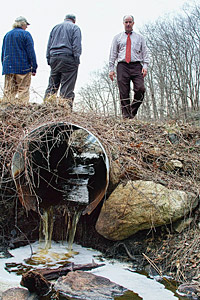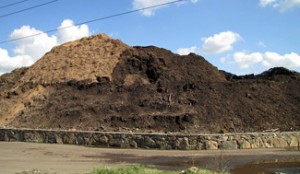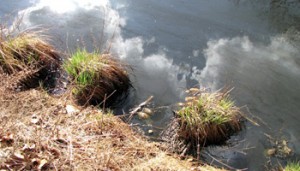The mystery of the Four Corners Fish Kill in Tuxedo continues, like a Charles Durning Texas two-step, where the Governor slides this way and that, obliquely answering ‘could be’ to most all questions.
The known knowns, to use a Rumsfeldianism, are that in late March, a large fish die-off was discovered at Four Corners Pond and Warwick Brook waterways. Many pointed fingers at the steamy Perfect Cut mulch pile on Long Meadow Road as a possible culprit. A Suffern-based landscaping company, Perfect Cut leases out Tuxedo Public Works land, which is located in Sterling Forest State Park and adjacent to wetlands that have experienced water quality problems.
Doc Bayne, former Environmental Educator of Sterling Forest State Park, will present evidence from his fact-finding mission on the Mystery of the Four Corners Fish Kill in a half-hour illustrated lecture open to the public Thursday evening in Tuxedo, with Palisades Park Executive Director Jim Hall scheduled to deliver opening remarks.
 After field investigations and interaction with the Town of Tuxedo, the NY Department of Environmental Conservation issued an April 13 Notice of Violation to the town, stating that ”DEC water tests concluded that evidence demonstrates that operations at the facility has resulted in numerous water quality impairments that has caused the fish kill.” The DEC reported that test results documented poor water quality conditions in numerous sites adjacent to and downstream of the mulch site. The DEC also attached a fine to the order.
After field investigations and interaction with the Town of Tuxedo, the NY Department of Environmental Conservation issued an April 13 Notice of Violation to the town, stating that ”DEC water tests concluded that evidence demonstrates that operations at the facility has resulted in numerous water quality impairments that has caused the fish kill.” The DEC reported that test results documented poor water quality conditions in numerous sites adjacent to and downstream of the mulch site. The DEC also attached a fine to the order.
 Tuxedo responded with an April 23 letter to the DEC that said the town’s investigation showed the “proximate cause” for the fish die-off was the removal of “certain beaver dams” by Palisades Interstate Park Commission crews that sent oxygen depleted waters downstream, killing aquatic life. The Tuxedo letter proffered several reasons for the oxygen depleted waters, including “nutrification from the wood chip facility.” In effect, the town stated that it “has been and remains in compliance” with environmental regulations.
Tuxedo responded with an April 23 letter to the DEC that said the town’s investigation showed the “proximate cause” for the fish die-off was the removal of “certain beaver dams” by Palisades Interstate Park Commission crews that sent oxygen depleted waters downstream, killing aquatic life. The Tuxedo letter proffered several reasons for the oxygen depleted waters, including “nutrification from the wood chip facility.” In effect, the town stated that it “has been and remains in compliance” with environmental regulations.
What caused the fish die-off? The removal of a beaver dam? Or possibly acidic waters welling up from an old iron mine in the vicinity of the mulch pile? Or perhaps the mountainous mulch pile itself could be contaminating wetland waters. Complex issues are at stake, including the viability of a business, a revenue model for Tuxedo and the continued health of area wetlands that eventually lead to the Ramapo River.
 Thursday evening noted former Environmental Educator and Historian for Sterling Forest State Park Doc Bayne will attempt to bring some clarity to the matter when he makes a public presentation at George Grant Mason Elementary School at 7 p.m. in Tuxedo. His multi-media effort is titled The Mystery of the Four Corners Fish Kill.
Thursday evening noted former Environmental Educator and Historian for Sterling Forest State Park Doc Bayne will attempt to bring some clarity to the matter when he makes a public presentation at George Grant Mason Elementary School at 7 p.m. in Tuxedo. His multi-media effort is titled The Mystery of the Four Corners Fish Kill.
Sterling Forest Partnership co-chair Sue Scher reported that Executive Director of the Palisades Interstate Park Commission James F. Hall will deliver opening remarks.
 “I’ve been in the park since 2000 and have hiked the streams and have been all around the park,” said Bayne. “I have gone out, and starting at the Ramapo River, walked from the Ramapo Warwick Brook up to Wee Wah Dam, Wee Wah Lake, then up the Warwick Brook through all of the wetlands, all the way up to the headend streams that starts the Warwick Brook.”
“I’ve been in the park since 2000 and have hiked the streams and have been all around the park,” said Bayne. “I have gone out, and starting at the Ramapo River, walked from the Ramapo Warwick Brook up to Wee Wah Dam, Wee Wah Lake, then up the Warwick Brook through all of the wetlands, all the way up to the headend streams that starts the Warwick Brook.”
Bayne said that during his hikes he documented the landscape, especially the waterways. His field work also involves ash trees that were observed at the mulch site. Currently, ash trees are a quarantined tree specimen in Orange County, due to the Emerald Ash Borer, a tree-killing beetle. DEC regulations prevent ash trees from entering or existing within Orange County limits.
“In my slide presentation, the red foam starts with all the dead clams at the Ramapo River,” Bayne said. “And I follow this mystery, questioning what caused this, where did it come from? And I follow that all the way up past the mulch pile to the head ends, where the Warwick Brook starts. At the beginning of Warwick Brook, there are fish and aquatic insects, and then that ends past the mulch pile.”
Bayne said that not only did fish die in the waterway kill, but turtles, frogs and other aquatic life such as salamander, clams and mussels died, even water bugs.
Bayne’s presentation will also provide insight into the beaver dam effect, a dam Bayne said gets taken down regularly every four to six weeks by the county, depending on rain fall, to prevent flooding Long Meadow Road. “The county for some reason will come down with a backhoe, pull the dam out of the water, leave it, and that night the beavers come, take it back off the road and start rebuilding it,” he said.
“I’m a concerned person,” Bayne said. “I’m just presenting a mystery. It’s important to people. Right now, 276 acres of wetlands have been poisoned, and that is coming from the parks, they mapped it out. I’m not accusing anyone, I’m just showing what I found. Being involved with the Friends of Sterling Forest, I want Sterling Forest to survive.”
Former Environmental Educator and Historian of Sterling Forest State Park Doc Bayne will present a multi-his media slideshow, The Mystery of the Four Corners Fish Kill, at George Grant Mason School Thursday at 7:00 p.m. The lecture is open to the public and contains a question and answer session. Palisades Park Executive Director Jim Hall is scheduled to deliver opening remarks.
Source: Photos courtesy of Geoff Welch andHomer Horowitz.
More At SloatsburgVillage
Mulch Pile The Movie — Follow an oozing a dark reddish something or other through streams.
DEC Lowers Boom — Follow the paper trail and the ins and outs related to the Four Corners Ponds fish die off.


